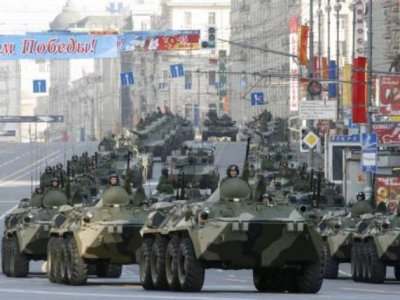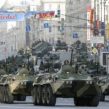
Russian Ground Forces Lose Out in Modernization Plans
Publication: Eurasia Daily Monitor Volume: 8 Issue: 7
By:

The modernization of the Russian armed forces, as currently planned for the next decade, appears to squeeze resources for re-equipping the Ground Forces. An article in the defense ministry’s official publication, Krasnaya Zvezda, unsurprisingly confirmed that modernizing the strategic nuclear arsenal will take the lions’ share of the defense budget, however, the order of priority places air defense and space troops as well as the air force and navy ahead of the ground forces. Moreover, more broadly, Russia will increasingly purchase arms abroad, though this is unlikely to solve the problems facing plans to modernize the weapons and equipment inventory (Krasnaya Zvezda, December 29, 2010).
Reflecting the weaknesses of the domestic industry to supply a range of products to the Russian armed forces, the shopping list for a foreign spending spree appears to be growing. However, this not only provides evidence about the condition of the defense industry, it equally exposes planning weaknesses. On November 25, 2010 Russian President Dmitry Medvedev visited the Gorokhovets training range in Nizhniy Novgorod Oblast, observing tactical Ground Forces’ exercises, testing an unmanned aerial vehicle (UAV) and inspecting an autonomous field camp. Partly designed to promote the image of the ongoing military reform, Medvedev took particular interest in new field tents, imported from Germany. Learning that the heating system, kitchen equipment and even the bio-toilets were also imported, the Russian president lamented: “You would think we could make something ourselves.” Defense Minister, Anatoliy Serdyukov, no doubt tongue-in-cheek, assured his commander-in-chief that the blankets were Russian (Rossiyskaya Gazeta, November 30). Medvedev’s frustration with the lack of domestically produced items highlights the defense ministry’s appetite for buying abroad. However, it is unclear whether the defense ministry is accurately reporting on either the progress of the reform to the Kremlin or indeed on critical issues relating to defense procurement.
For example, no one informed Medvedev that the German field tents were not designed to withstand the extreme sub-zero temperatures of the Russian winter. Approximately one year earlier, the same German field tents were pitched in Gorokhovets in temperatures slightly above freezing, within a few days after a drop to minus twenty, efforts to fold the tents resulted in cracks appearing and they began falling apart. Nezavisimoye Voyennoye Obozreniye’s correspondent, Oleg Vladykin, reportedly witnessed a revealing conversation at Gorokhovets on November 25, 2010 between a representative from a domestic defense company that produces similar products, asking Margarita Andreyeva, the Chief of the defense ministry’s State Order Directorate: “Do you know that German tents are designed for a temperature of no lower than minus 17?” Andreyeva replied: “Yes, I know, but we bought them already” (Nezavisimoye Voyennoye Obozreniye, November 30, 2010).
Puzzling features of this procurement policy are equally apparent in the more potentially serious problems facing the equipping of the Ground Forces with automated command and control systems. Problems in this sphere are also victim to competing efforts to either pressure the domestic defense industry or to purchase abroad, not least in the acquisition of UAV’s. The 5th Motorized Rifle Brigade at Alabino, near Moscow, has continued testing the tactical-level single command and control system (Yedinaya Sistema Upravleniya v Takticheskom Zvene –YeSU TZ). Pictures from UAV’s have shuddered, problems were experienced with coordinates and targets that should be fixed reportedly “moved” on the screen. Nonetheless, defense industry specialists noted the same problems would emerge using foreign purchased UAV’s as the fault lies in the software for the YeSU TZ (Nezavisimoye Voyennoye Obozreniye, November 30, 2010).
Publicity surrounding the YeSU TZ, referred to by one brigade commander as the “eighth wonder of the World,” has been largely positive. Nevertheless, claims by the top brass that the Ground Forces will have fully automated command and control systems by 2012, or that by 2015 such a system will be the best in the World, should be regarded with caution. This innovation faces technical, planning and financial constraints, not least in reference to computers produced for the military costing up to twice as much as for the civilian market. It also faces the bureaucratic hurdle of coordinating design improvements between the defense ministry, General Staff and the domestic defense industry (Nezavisimoye Voyennoye Obozreniye, November 19, 2010).
The Mistral contract with the French company DCNS (2 billion Euros) has been the highest profile example of Moscow procuring military hardware abroad. Yet, a deeper pattern has emerged abandoning the traditionally self-referencing approach to procurement. Examples include: armored vehicles from the Italian IVECO (250 million Euros), Israeli BirdEye, MK 150, MKII UAV’s ($53 million), 5,000 British sniper rifles ($5 million), and undisclosed sums spent on the French SIGMA-95 navigation system for MiG-29’s, FELIN infantry combat gear, as well as Thales thermal imagers for T-90 tanks, German mountaineering equipment for two Mountain Rifle Brigades in the North Caucasus (Trud, November 30). Since procuring the Israeli UAV’s, only 50 Russian specialists have been trained to maintain the light platforms (Argumenty Nedeli, December 8, 2010).
Konstantin Makienko, the Deputy Director of the Moscow-based Center for the Analysis of Strategies and Technologies (CAST), believes foreign purchases will become a regular practice. “With the exclusion of our domestic shipbuilding sector from the order for a universal amphibious assault ship, it has become absolutely clear that in the future the national defense industry is ceasing to be the exclusive supplier for the Russian armed forces,” Makienko asserted. However, these foreign purchases are likely to be limited in scope, and will not provide a viable alternative to domestic procurement, while some analysts see dangers in buying weapons and equipment abroad, pointing to a potential embargo during a future crisis. Makienko considers this risk can be managed by focusing on buying from France, Italy and Israel, partners which he characterizes as conforming to the principle of “maximum de-politicization” (Trud, November 30).
The Russian Ground Forces appear to be receiving only small numbers of main battle tanks and artillery, perhaps indicating a shift in the approach towards modern combat. However, given the level of secrecy in the defense budget and lack of scrutiny and accountability this is difficult to establish with any degree of accuracy. Yet, the lowly status of the Ground forces in the pecking order suggests they will only receive the leftovers after the feeding frenzy by other arms and branches of service.




